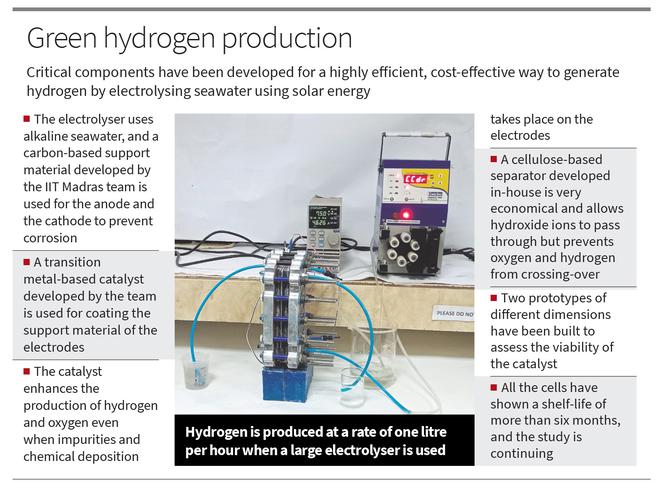Researchers from the Department of Physics at IIT-Madras have developed critical components for a highly efficient, cost-effective way to electrolyze seawater to generate hydrogen. The results were published in the journal ACS Applied Energy Materials.
State-of-the-art alkaline water electrolyser technology is energy-intensive, requires an expensive oxide-polymer separator, and uses fresh water for electrolysis. The IIT-Madras team led by Dr. Ramaprabhu Sundara has addressed each of these challenges by developing simple, scalable and cost-effective alternatives that are highly efficient in splitting seawater and generating hydrogen.
In place of pure or fresh water, the team has developed an electrolyser using alkaline seawater. They used a carbon-based support material for the electrodes instead of metals to almost eliminate the possibility of corrosion. They also designed and developed transition metal-based catalysts that can catalyse both oxygen and hydrogen evolution reactions. The catalyst enhances the production of both hydrogen and oxygen even when impurities and chemical deposition on one of the electrodes takes place. Also, the researchers have developed a cellulose-based separator that is very economical and serves the purpose of allowing hydroxide ions to pass through but prevents oxygen and hydrogen that are generated from crossing-over. Finally, the researchers have optimised all the parameters such that the water electrolyser can directly use photovoltaic-derived voltage to split seawater and generate green hydrogen and oxygen, oxygen can be used elsewhere.
The reactions
Alkaline water electrolyser consists of two half-reactions occurring at the anode and cathode. At the cathode, water dissociates into H+ and hydroxide ions, and the H+ ions get converted into hydrogen. The hydroxide ions produced at the cathode permeate through the separator and oxygen is generated at the anode.
When seawater is used for electrolysis, hypochlorite formation occurs at the anode. Hypochlorite is responsible for corrosion of the electrode support material, and competes with the oxygen evolution reaction thus reducing the amount of oxygen produced. At the cathode, the hydrogen evolution reaction is slowed down when several impurities get adsorbed on the electrode surface.
The electrodes have a support material that is coated with a catalyst. “Since conventional metal support materials get easily corroded when seawater is used, we developed a carbon-based support material,” says Prof. Sundara. “The support material is used in both the anode and cathode, and is coated with the catalyst. The catalyst allows enhanced and simultaneous production of hydrogen at the cathode and oxygen at the anode.”
According to Prof. Sundara, the transition bimetals present in the catalyst are more selective towards oxygen evolution reaction than hypochlorite formation. Thus the challenge of hypochlorite formation reducing oxygen production is taken care of. Similarly, even while the cathode continues to adsorb impurities, the catalyst promotes the hydrogen evolution reaction, which helps in the increased production of hydrogen.

The separator
Another unique feature is the novel separator that has been developed by the team. When alkaline electrolyte is used, the anode and cathode are separated with a separator. Since zirconium oxide-based material that is routinely used is expensive, they came up with a cellulose-based separator which allows the hydroxide ions to pass through from the cathode to the anode. But it minimises the crossover of hydrogen and oxygen that is generated.
“We found our separator is highly resistant to seawater degradation,” says Sana Fathima, one of the co-authors of the paper.
“Using the assembled electrolyser, we have demonstrated an overall seawater splitting voltage of 1.73 V at 10 mA/sq.cm (a benchmark current density corresponding to about 12% efficient solar-to-fuel conversion device under 1 sun illumination) at 26 degrees C,” says Anamika Ghosh from IIT Madras and the first author of the paper. “We have optimised all the parameters such that the water electrolyser can directly use photovoltaic-derived voltage and work at 10mA/sq.cm current density to split seawater for green hydrogen production.”
The team has developed two prototypes of different dimensions to assess the viability of the catalysts. “In the case of the smaller electrolyser (16 sq.cm dimension) hydrogen is produced at a rate of 250 ml per hour, while in the larger one (391 sq.cm dimension) hydrogen is produced at a rate of about one litre per hour at an applied voltage of 2 V,” Ms. Ghosh says. “We also fabricated a stack consisting of three such cells and hydrogen produced is about four litres per hour at an applied voltage of 2 V per cell.” All the measurements were done at ambient pressure and room temperature.
“All the cells have shown a shelf-life of more than six months, and the study is continuing,” says Ms. Fathima.







